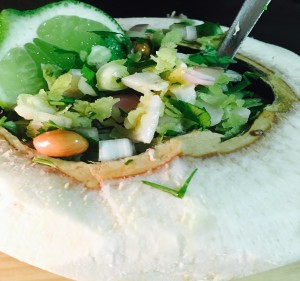Growing up dadpe pohe used to be an occasional snack that our mom’s used to make at tea-time. It is for the second time that we feature pohe on our blog after the misal recipe. For both the recipes we used the thin poha. Poha are dried flattened rice flakes and used quite a bit in various recipes in India. These are easily available at indian grocery stores or online. In Madison you can find them here.
The dadpe pohe recipe is quite simple. In our house mom used to make it with a slightly mature yet fresh coconut. This has more meat and less water. According to an anecdote we are told, in the coastal areas of Maharashtra where coconut grows in abundance, this would be a breakfast or evening snack the day coconuts were harvested. Usually that would mean an abundance of coconuts at home. When they would break open a coconut they would add the poha in the half of the coconut along with some of the water and leave it in there packed to soak up and infuse the flavors from the coconut water as well as the coconut meat. This is maybe where it gets its name “dadpe” from the action “dadapne” which i think means something on the line of to pack and hide.
When i was doing our bachelors, we had gone on a plant visit to study the refrigeration at a grape packaging plant on the outskirts of pune. One of our very good friend Nikhil’s grandparents who had a beautiful traditional house called “Wada” in the countryside. We were lucky to be invited to their house and to be showered with their hospitality. As 15 of us sat around the courtyard of their house we were served dadpe pohe made by my friends aunts. They were fantastic and tasted creamier and fresher than ones i had till then. When i asked for the secret, i was told that the coconut and coconut water used was from the tender coconut or “shahala” as it is known in marathi. This little tip has stuck with me. The meat of tender coconut is a thin, almost creamy layer and it melts in the mouth. This silky meat is called “khobra malai” because of this texture which means coconut that tastes and feels like the cream top of milk. This recipe has always stayed with me since then. We all gorged on this delicious snack and some of us went for a swim in the nearby river. What a perfect getaway that was. If you have never had “cream top” or malai before and are in Madison i suggest you buy a bottle of Kalona whole milk from Hyvee or traderspoint creamery whole milk from whole foods here to give it a try.
Although it is not traditional my mom had a fantastic secret ingredient to add to the recipe. This is finely chopped ginger. Fresh Coconut and ginger do get along really well and when i tried this it has become part of our house recipe. It adds some sharpness to the acidity that comes from lime juice, especially it works well in this version which uses the creamier and sweeter coconut.
So when i ran into fresh coconut available at our grocery store (i think this one was melissa’s cocnut) i decided to make Dadpe Pohe. Use a sharp heavy knife to do the trimming work so that you can breach the hard shell and make the coconut opening bigger in which case you can use it as a cup to serve as well to “dadap” the poha :). Once you have broken the coconut, collect the water and scrape the meat, being careful not to scrape the woody part. If you dont get all of it thats okay if you use this as your serveware. When you finish the poha, its a special treat to scrape and eat bits and pieces of this tender coconut meat.
Other than the vegetables mentioned in the recipe, we urge you to experiment and play with your own favorites. Any ingredient which seem to be at home in a crunchy chopped salad should be game. Tart crunchy tomatoes can also bring their acid into play while bell peppers of various colors can be diced to add more texture.If you do try out some variations, do take a picture to share with us and let us know how it worked.
We also created a little video which we uploaded to our youtube channel.Hope you enjoy our house recipe for Dadpe Pohe.
PrintDadpe Pohe
- Yield: Serves 2
Description
Dadpe pohe is a snack popular in maharashtra, india but also appears in various forms throughout the coastal regions with abundance of coconut.
Ingredients
- Copped Tender coconut meat from fresh young coconut (about 0.5 cup) (substitute with fresh frozen coconut)
- 1 tbsp coconut water
- 0.5 cup thin pohe (flat rolled rice) that are lightly toasted for 2 minutes in a big flat pan on low heat
- 0.5 cup chopped red onion
- 0.5 cup chopped cilantro
- 2 tsp finely chopped chopped ginger
- 2 tsp roasted peanuts with skin
- salt to taste
- 0.5 tsp sugar
- juice of half lime
- 2 tsp oil
- 1 tsp mustard seeds
- 1 chopped green chili
- 0.5 tsp asafoetida
- 0.5 tsp turmeric
Instructions
- arrange poha, coconut, chopped onion and cilantro mixture in a big plate or flat container
- Heat oil in a small pan for tempering
- Add mustard seeds, let crackle, add green chilies, add asafoetida and turmeric
- pour oil over coconut and onion mixture
- add the coconut water to plate and mix all ingredients in plate together
- Squeeze half the juice from the lime, mix
- Cover and let rest for 20 minutes
- season with salt and sugar, add peanuts and mix, finish with another squeeze of remaining lime juice
- Serve in coconut shells or bowls
- Cuisine: indian maharashtrian



Mouthwatering!! My grandmother who was from jalgaon where obviously fresh coconuts would be a rarity, made a variation using watered leftover buttermilk instead of the cocunut milk. It gave the pohe some tang and we could have them on demand, coconut or not…..